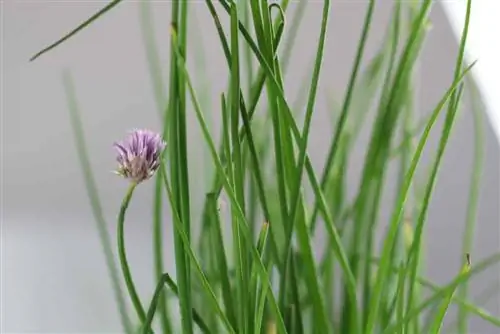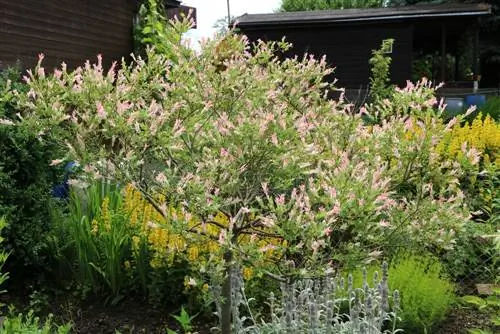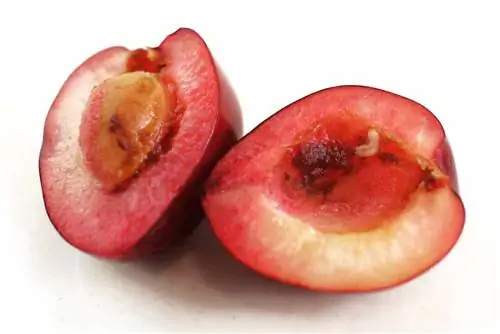- Author admin [email protected].
- Public 2023-12-17 03:39.
- Last modified 2025-01-24 12:45.
On the other hand, caring for them is quite simple and the cherries' soil requirements can also be easily met. Due to the variety of possible locations, they are very easy to integrate into your own garden.
The right time to prune
Japanese ornamental cherries have special properties that are crucial for growth and pruning.
- Spring bloomers from the beginning of March to the end of May
- develop a lot of plant sap in winter
- form different growth forms
- cut sensitive
Combined, these properties result in a tree that, despite its strong growth, cannot tolerate large cuts, especially not in winter. The cut should therefore be done in a warm season, ideally in June, because ornamental cherries cannot bleed and the individual branches can grow back strongly but in an orderly manner. If you want to make a shape-changing cut, you should do it in mid-autumn as this will allow the cherry to get used to the new shape. When cutting the cherry as a whole, however, it should be noted that it should only be cut after about three years, as it will then have developed a certain hardness.
First pruning of the Japanese ornamental cherry
When cutting for the first time, special attention must be paid to the entire type of tree. You should thin only very slightly, targeting the oldest shoots that are deep above the ground. They usually have cracked bark that is darker than that of the younger shoots. In the long run, they become too heavy for the tree and prevent it from growing straight and not too branched, as the old branches have a tendency to do so. If the tree is already very branched, the side shoots should also be cut, otherwise they will grow.
Prune Japanese ornamental cherries annually
Careful pruning is increasingly used for the flowering cherry, as it can be sensitively disturbed. The tree can quickly become too large and so when planning the annual summer pruning, owners should ensure that the tree is the right size. When cutting, all dead branches are carefully removed and you should definitely use clean cutting tools because the cherry can quickly become sick. In addition to the dead branches, all disturbing twigs and shoots should be removed. This refers to the parts that either grow too quickly or inwards and could therefore disrupt the overall growth of the other shoots. So-called wild shoots are also a common phenomenon. Remove these too. This works from March to September because they don't bleed.
The editing goes like this:
- find the branch
- set straight and as far as possible on the trunk
- cut with a suitable tool
- Remove residue
- Attention: be sure to apply a wound closure agent
- Do not dispose of cuttings in the compost, but rather in green waste
For large and heavily branched trees, the side shoots should also be removed, as these can continue to form more shoots. Be sure to leave behind a branch structure that is still open at the top and has been cut as cleanly as possible. This gives the cherry stronger growth and a more beautiful shape. If you want to strengthen the stem's cell walls even further, you should add potassium in late summer. Then the topiary should be skipped. Never cut too hard into the old wood, just so that the false shoots can be removed. This could give the tree an unsightly growth that is difficult to correct.
The important shape cut, for example if a flat crown is desired, mainly happens in October. Here, if you have the necessary expertise, simply cut the crown to the desired shape.
The necessary tools for pruning
Classic tools are sufficient for cutting the ornamental cherry, but they should be of a certain quality. Particular emphasis should be placed on scissors in this topic. When it comes to cherries, you always need very sharp pruning shears, which can also be equipped with a telescopic handle. It should also be kept sharp, because the tree is sensitive here, as protruding remains do not promote pleasant growth. A very smooth wound should be created, which is then treated with a suitable wound closure agent. This allows the cherry to close the wound areas well and promote further branches for the next year, which will then correspond to the desired shape. If the branches are very thin, which can happen with an old cherry, then you should use electric saws or scissors that cut the branch off efficiently and efficiently. This also guarantees clean growth and shoots.
Recommended tools
Cutting the Japanese ornamental cherry correctly is not difficult with the right tools. Manufacturers such as Fiskars, Siena Garden and Wolf have proven themselves particularly successful in this procedure. They not only offer a sharp blade, but also an anvil function that can be used very well given the strength of the branches. Gardena, Fiskars and Felco are suitable for small branches.
Conclusion of the pruning
Japanese ornamental cherries are particularly popular as decoration in front gardens. They are one of the first plants to impress with a large display of flowers in spring and transform the lawn into a pink and white carpet of flowers. Cutting the Japanese cherry is not rocket science and can be done well with the necessary preparation and high-quality tools. Regardless of whether it is a cherry tree or a bush, it is easy to shape and creates he althy accents in the garden.
Flowering time
- There are now countless hybrids and species of the Japanese ornamental cherry with a wide variety of varieties.
- These differ primarily in the color and shape of the flowers, in their growth and the time of flowering.
- While some are already in a breathtaking sea of flowers at the end of March, others only open in late May.
Blending cut
- Only the oldest shoots should be cut out.
- The best time for thinning and pruning is spring.
- Although you can see better how the bush is branched in winter, cutting it in winter leads to stronger sprouting in summer.
- If this is not desired, the cut should be postponed until spring.
Small and large pruning
- Since pruning should be kept to a minimum, only the oldest shoots that are close to the ground should be cut off.
- You can recognize older shoots because their bark is much darker and more cracked than is the case with young shoots.
- If it is a very branched shrub, the side shoots are also shortened.
- For a larger ornamental cherry, extensive pruning is carried out so that the plant can sprout again in all its glory.
- The best time for major pruning of a Japanese cherry is spring. You will see the success in the following year.
- With this pruning, only a branch structure is left standing on which the shoot will then grow in the following season.
- Be careful: do not cut into the old wood!






